Dying to Live Forever:
The Reasons behind
Self-Mummification

The body of Shinnyokai Shonin, found in
Oaminaka, Japan. He had practiced self-mummification. Photo Credit: Ken
Jeremiah
Sunada Tetsu (1768-1829) was arguably the most famous individual who successfully mummified himself. Early in life, he was not religiously inclined. He loved a prostitute in Akagawa, Tsuruoka’s pleasure quarters, and although the incident’s specifics are unclear, one day he fought two samurai over the girl. They drew their swords, and he killed them.
To escape punishment, which would have been death, he fled to Churen Temple in Oaminaka. There, he embraced the Shugendo faith and became an ascetic. His austere training was an inspiration to other like-minded people, and they followed him.
They toured Japan, repairing temples and building bridges, and they helped all they could. An eye disease was blinding people in Edo (modern-day Tokyo), and Tetsu lacked the means to (secularly) help them. Praying for a cure, he cut out his own eye and threw it into the Sumida River. After years of continuous asceticism, he buried himself alive.
He said, “As long as I have a body, even if I work myself to the bone, I can still bring salvation to humankind. However, if I die, I cannot. To continue bringing salvation to humankind, I have to leave my body in this world and become a sokushinbutsu (one who has attained Buddhahood in the flesh).”
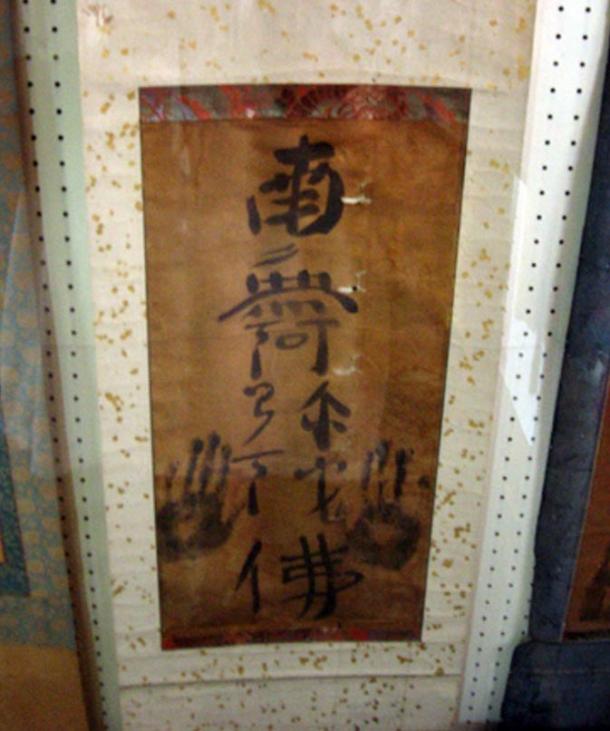
Tetsumonkai’s hand scroll. Credit: Ken
Jeremiah
Tetsumonkai, as others called him, engaged in a strange diet called mokujikigyo (tree-eating), which involved eliminating grains. Over the course of 3,000 days, he reduced the amount of food ingested so at the end, he would starve to death.
He supplemented his meager intake with strange substances like pinesap, pine needles, butterburs, and bark, thinking that such items would help to preserve his body. In 1829, when he was 62 years old, there was a banquet, and all of his friends and disciples gathered. He remarked that it was great to die surrounded by such great people. The next day, he stepped into a coffin in Churen’s main hall with a bell. It was sealed and then lowered into an earthen hole.
A small bamboo tube provided oxygen, and he chanted and rang the bell until he died. Once his followers heard silence, they did something unusual; they pulled him out and dried his body with candle fires and incense. (Normally, such bodies were untreated.) Then, they reburied him for three years, after which they unearthed and redressed him before enshrining him in the main hall at Churen Temple. Since he had mummified, he was called sokushinbutsu: Living Buddha.
It was thought that he had attained a state called nyujo, which was like suspended animation: neither alive nor dead. Many wanted to achieve this state of being, though less than 20 in Japan are considered to have been successful. The reasons behind such a desire are complex, and they connect to the Chinese Daoist pursuit of immortality, which influenced Ch’an (Zen) Buddhism and other faiths.
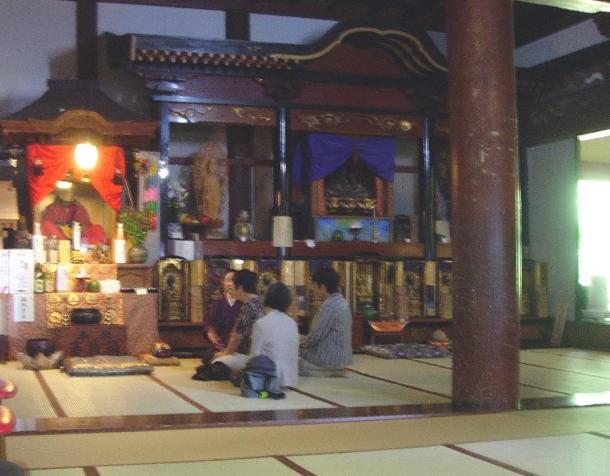
Some visitors sit in front of Tetsumonkai,
Churen Temple, Japan. Credit: Ken Jeremiah
The early Chinese believed that the soul was composed of multiple parts (called hun and po), and after death, these parts dissipated, therefore never perpetuating the existence of the deceased. The only way to keep them together and thus continue (living) in a spiritual form was to leave the body intentionally, as a cicada leaves its husk, and intentionally exiting the body required awareness at the moment of death. Some Ch’an monks died and then naturally mummified in meditative posture, and it was believed that they had accomplished this feat. Many Chinese ideas entered Japan and were absorbed by the Shugendo tradition (which was itself assimilated into Shingon Buddhism). The monks who chose to mummify themselves similarly believed that they must be mindful when the transition from life to death began.
They thought of it like a dream. If you do not know you are dreaming, you are just swept up into your surroundings, but if you recognize that you are in a dream, you can consciously control your actions; you might even be able to affect the dream’s substantive nature. This is called lucid dreaming. The sokushinbutsu (self-mummified monks) viewed death similarly. To maintain awareness, and to keep their spiritual essence intact, they caused their own deaths. This explains one of their actions. A different idea justified their bodily preservation.
When people joined the Shugendo faith, they became issei gyonin, a term that means “one who is an ascetic for his or her entire life.” Adherents trained at a special place near Mt. Yudono called Senninzawa (literally, hermit’s mountain stream). Stone markers record their deeds. They mention those who secluded themselves on mountains for a thousand days, and others who fasted (from cereals) for three thousand.
Such individuals sometimes performed even more incredible austerities, like setting fire to their fingers, cutting off body parts, or torturing themselves in other ways. These practices, justified by an interpretation of Lotus Sutra passages, were thought to create merit: an energy source that infuses the physical body.
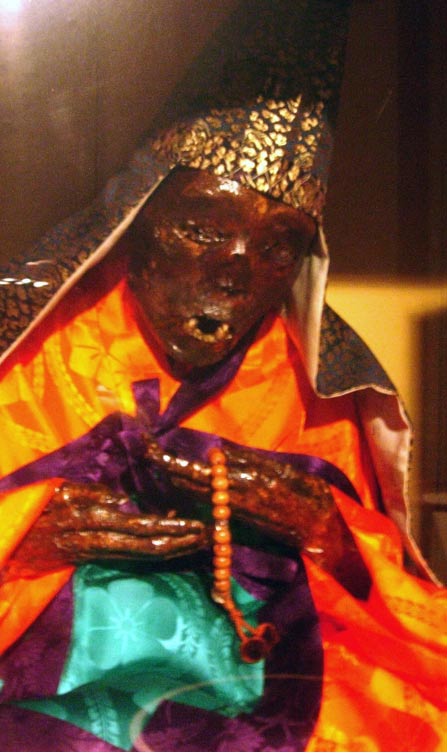
The Self-Mummified Monk Enmyokai (d. 1822). Credit: Ken Jeremiah
A similar idea exists in Catholic Christianity. Its clergy preserves the bodies of saints and venerables, believing that they are reservoirs of divine power. In early Christianity, the faithful slept near perceived holy bodies because they thought such proximity would facilitate their entrance into heaven. They also believed that miracles could occur by praying near holy corpses. According to the self-mummified monks’ beliefs, merit is the energy within the body that could permit such miracles.
They also believed that a correlation exists between the spirit and body. If the body is stressed, the spirit strengthens. Since this energy could benefit humankind, they embraced asceticism to increase spiritual strength. However, they faced a conundrum. If they did not quit their bodies, they could not serve Maitreya, the Future Buddha, in the Tusita Heaven. But if their bodies were destroyed, the merit that infused them could not benefit others. For this reason, they adopted a diet that encouraged bodily preservation, and then buried themselves alive.
Self-mummification was a complicated process, and few who attempted it were successful. Many perished before their interments. Ishinkai (d. 1831) died before completing a 2,000-day cereal fast, and Zenkai (d. 1856) did not make it through 1,000 days. Besides those who died, others changed their minds during the lengthy auto-mummification process. It is a difficult thing to plan one’s own death through years of self-imposed torture.
Only truly unique individuals could have the dedication and focus needed to attain this incredible goal. Of the many people who attempted the process, approximately 30 were successful. Seventeen of their bodies are extant, and ten are still enshrined in northern Japanese temples. They include Togashi Kichihyoei (1623-1681), a samurai retainer who became a priest and took the religious name Honmyokai, and the farmer Shindo Nizaemon (1688-1783), who became Shinnyokai.
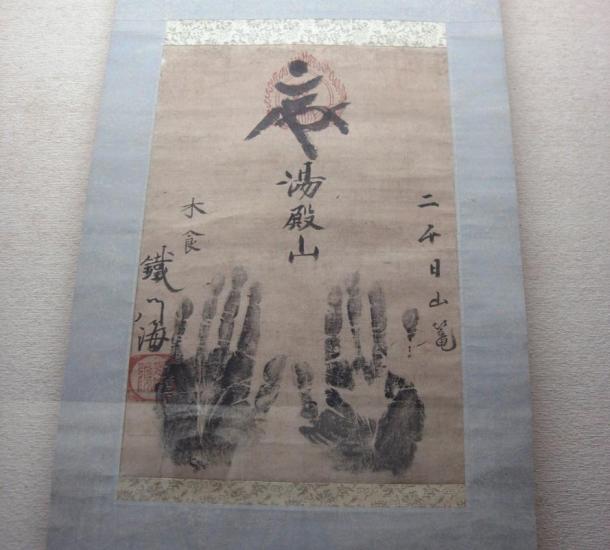
The hand-scroll of a monk called Testusenkai,
which commemorates a 2,000-day fast. Credit: Ken Jeremiah
Their bodies, along with others, are preserved. Some have flesh on their faces, torsos, and hands, while others are mostly skeletons. Even if one had successfully mummified, time eventually destroys. It keeps affecting bodily destruction, as everyone will one day return to dust. Nevertheless, such monks are still seated in meditative posture, dressed in priestly garments. They are considered living Buddhas, the equivalent of Saints, Bodhisattvas or Arhats, and according to locals, their spirits are still present, assisting humankind.
References:
Hijikata,
M. (1996). Nihon no Miira
Butsu wo Tazunete. [Visiting Japanese Buddhist Mummies]. Tokyo:
Shinbunsha.
Jeremiah,
K. (2010). Living Buddhas:
The Self-Mummified Monks of Yamagata, Japan. North Carolina:
McFarland & Co., Inc.
Matsumoto,
A. (2002). Nihon no Miira
Butsu. [Japanese Buddhist Mummies]. Tokyo: Rokkō Shuppan.
Sokushinbutsu and the ancient Japanese monks that mummified themselves to death
Over 1,000 years ago, a practice was pioneered by a Japanese priest named Kukai, which was intended to demonstrate the ultimate act of religious discipline and dedication – self-mummification. The practice, known as Sokushinbutsu, was a ritual observed over numerous years, which culminated in death and the complete preservation of the body. If successful, the monk was posthumously placed in a temple for others to see and honor.
Kukai (774 – 835 AD) was a Japanese monk, civil servant, scholar, poet, artist, and founder of an esoteric sect known as Shingon, which combined elements from Buddhism, Old Shinto, Taoism, and other religions. He and his followers practiced Shugendo, a philosophy based on achieving spiritual power through discipline and self-denial. Towards the end of his life, Kukai went into a state of deep meditation and denied all food and water, eventually leading to his voluntary death. He was entombed on Mount Koya in Wakayama prefecture. Some time later, the tomb was opened and Kukai, known posthumously as Kobo-Daishi, was supposedly found as if sleeping, his complexion unchanged and his hair healthy and strong.
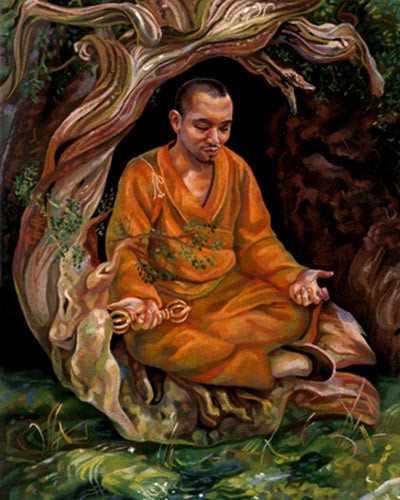
Kukai meditating to his death on Mount Koya (smallbrushfetish)
Since that time, the process of sokushinbutsu developed and evolved, and the process of self-mummification came to be practiced by a number of dedicated followers of the Shingon sect. The practitioners of sokushinbutsu did not view this practice as an act of suicide, but rather as a form of further enlightenment.
In Living Buddhas: The Self-Mummified Monks of Yamagata, Japan, Ken Jeremiah points out that many religions have viewed the incorruptibility of the corpse as a sign of special grace or supernatural ability.
The process of self-mummification
For the next one thousand days, their diet was restricted to just bark and roots. Near the end of this period, they would drink poisonous tea made from the sap of the Urushi tree, which caused vomiting and a rapid loss of body fluids. It also acted as a preservative and killed off maggots and bacteria that would cause the body to decay after death.
In the final stage, after more than six years of torturous preparation, the monk would lock himself in a stone tomb barely larger than his body, where he would go into a state of meditation. He was seated in the lotus position, a position he would not move from until he died. A small air tube provided oxygen to the tomb. Each day, the monk rang a bell to let the outside world know he was still alive. When the bell stopped ringing, the tube was removed and the tomb sealed for the final thousand day period of the ritual.
At the end of this period, the tomb would be opened to see if the monk was successful in mummifying himself. If the body was found in a preserved state, the monk was raised to the status of Buddha, his body was removed from the tomb and he was placed in a temple where he was worshiped and revered. If the body had decomposed, the monk was resealed in his tomb and respected for his endurance, but not worshiped.
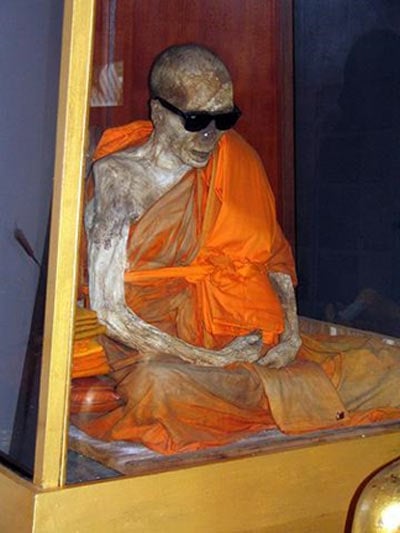
A Shindon monk who achieved
self-mummification (wikia)
This ancient practice of self-mummification continued until the 19th century when it was outlawed by the Japanese government. Today, sokushinbutsu is not advocated or practiced by any Buddhist sect.
It is believed that many hundreds of monks attempted sokushinbutsu, but only 28 are known to have achieved mummification, many of whom can be visited in various temples in Japan. The most famous is Shinnyokai Shonin of the Dainichi-Boo Temple on the holy Mount Yudono. Others can be found in Nangakuji Temple, in the suburbs of Tsuruoka, and at Kaikokuji Temple in the small city of Sakata.
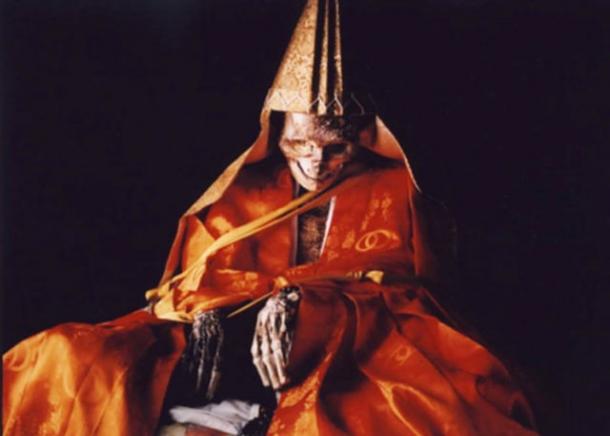
Shinnyokai Shonin of the Dainichi-Boo Temple
on the holy Mount Yudono (Atlas
Obscura)
References:
Sokushinbutsu: Self-mummification In Shingon Buddhism – IntrovertJapan.com. Available from: http://introvertjapan.com/2013/11/03/sokushinbutsu-the-self-mummification-of-shigon-buddhism/
Sokushinbutsu: Mummifying Yourself While You’re Still Alive – Tofugu.com. Available from: http://www.tofugu.com/2011/08/18/sokushinbutsu-self-mummifying-buddhism/
Sokushinbutsu – Wikia. Available from: http://it.creepypasta.wikia.com/wiki/Sokushinbutsu
The Gruesome and Excruciating Practice of Mummifying Your Own Body – io9. Available from: http://io9.com/the-gruesome-and-excruciating-practice-of-mummifying-yo-1515905564
Sokushinbutsu of Dainichi Temple – Atlas Obscura. Available from: http://www.atlasobscura.com/places/sokushinbutsu-dainichi-temple
From Ancient Origins @ http://www.ancient-origins.net/history/dying-live-forever-reasons-behind-self-mummification-003166
and http://www.ancient-origins.net/news-history-ancient-traditions/sokushinbutsu-and-ancient-japanese-monks-mummified-to-death-012938
For more information about mummified monks and
mummification see http://nexusilluminati.blogspot.com/search/label/mummies
- Scroll down
through ‘Older Posts’ at the end of each section
Hope you like this
not for profit site -
It takes hours of work every day by
a genuinely incapacitated invalid to maintain, write, edit, research,
illustrate and publish this website from a tiny cabin in a remote forest
Like what we do? Please give anything
you can -
Contribute any amount and receive at
least one New Illuminati eBook!
(You can use a card
securely if you don’t use Paypal)
Please click below -
Spare Bitcoin
change?
For further enlightening
information enter a word or phrase into the random synchronistic search box @
the top left of http://nexusilluminati.blogspot.com
And see
New Illuminati – http://nexusilluminati.blogspot.com
New Illuminati on Facebook - https://www.facebook.com/the.new.illuminati
New Illuminati Youtube Channel - http://www.youtube.com/user/newilluminati
New Illuminati on Google+ @ https://plus.google.com/115562482213600937809/posts
New Illuminati on Twitter @ www.twitter.com/new_illuminati
New Illuminations –Art(icles) by
R. Ayana @ http://newilluminations.blogspot.com
The Her(m)etic Hermit - http://hermetic.blog.com
DISGRUNTLED SITE ADMINS PLEASE NOTE –
We provide a live link to your original material on your site (and
links via social networking services) - which raises your ranking on search
engines and helps spread your info further!
This site is published under Creative Commons (Attribution) CopyRIGHT
(unless an individual article or other item is declared otherwise by the copyright
holder). Reproduction for non-profit use is permitted
& encouraged - if you give attribution to the work & author and include
all links in the original (along with this or a similar notice).
Feel free to make non-commercial hard (printed) or software copies or
mirror sites - you never know how long something will stay glued to the web –
but remember attribution!
If you like what you see, please send a donation (no amount is too
small or too large) or leave a comment – and thanks for reading this far…
Live long and prosper! Together we can create the best of all possible
worlds…
From the New Illuminati – http://nexusilluminati.blogspot.com
When ONE raises ONES conscious with ALL THAT IS, then ALL becomes a meditation, no need to sit in a lotus position and become a mummy! ALL of life is a mediation, every moment, every breath, every situation in action or rest, in sleep or debating in a phony court of law... once we realize this, life becomes a practice in humor, a kind of divine comedy of experience, which I find self mummification to be completely selfish practice in funny endeavors!
ReplyDeleteAh, but this isn't about life; it's about the 'afterlife', and an erect posture is entirely necessary for many specific yogic practices
DeleteThe quest for the after life is really just a distraction away from the moment
ReplyDeleteI'm more interested in my erect penis than erect postures,. And practicing eating
ReplyDeleteVarious yogurt flavors